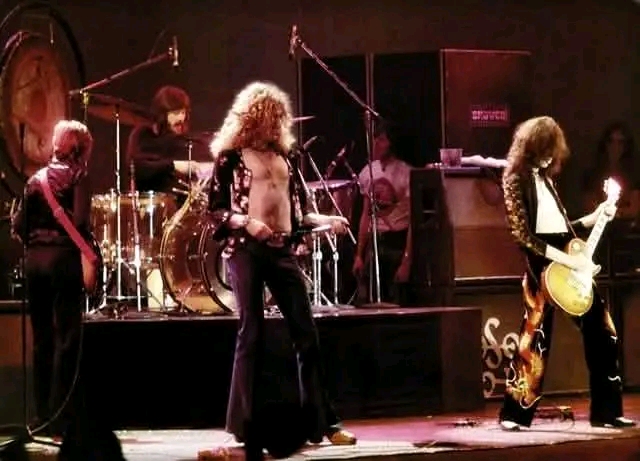In 1975, Led Zeppelin stood at the pinnacle of rock music, and one photograph captured by Michael Putland that year encapsulates the raw power and mythic presence of the band during this era. The image, now iconic among fans and rock historians alike, freezes a moment from their U.S. tour in support of the album *Physical Graffiti*—a tour that remains one of the most legendary in rock history.
Michael Putland, a respected British rock photographer, was known for his ability to capture artists not only in performance but in their most unguarded moments. His photograph of Led Zeppelin from 1975 is an embodiment of that skill. Shot in vivid black and white, the photo often shows the band immersed in a blaze of light and smoke, their bodies in motion, and the stage practically trembling with energy. Robert Plant, the golden-haired frontman, is typically seen mid-pose, shirt open, mic in hand, exuding charisma and sensuality. Behind him, Jimmy Page, hunched over his Les Paul guitar, is locked in a trance-like solo, his fingers a blur. John Paul Jones appears the quiet anchor, focused on his bass or keyboards, while John Bonham thunders behind the kit, sweat flying with each drum strike.
This photograph is more than just a visual of a band playing music—it is a window into the ethos of 1970s rock and roll. At that time, Led Zeppelin wasn’t just a musical group; they were a cultural phenomenon. Their concerts were grand, often three-hour epics filled with extended jams, elaborate solos, and otherworldly stage presence. Putland’s lens captures this perfectly, making the viewer almost feel the heat from the stage lights and hear the roar of the crowd.
1975 was a transitional year for the band. Having released *Physical Graffiti*—a double album that showcased their range from hard rock to acoustic ballads—Led Zeppelin was evolving musically and stylistically. The tour that followed saw them playing sold-out arenas and stadiums across the United States, asserting their status as perhaps the most dominant force in rock at the time. The scale and ambition of their performances mirrored the excess and grandeur of the rock lifestyle of the 1970s.
Michael Putland’s photo also subtly highlights the dynamics among the band members. There’s a chemistry between them that leaps off the image—a shared energy and intensity, yet also a distinct individuality. Each member brings something unique, and Putland’s framing respects that, allowing their personalities to shine even in a single frozen moment.
In the decades since, this 1975 photo has become more than just a picture of a band onstage. It’s a cultural artifact. It reminds us of a time when rock music was at the center of youth culture, and Led Zeppelin reigned as titans of the genre. For fans, it is a cherished glimpse into a golden age. For music historians, it is a reminder of how performance, style, and charisma could be distilled into a single, timeless image. Through Michael Putland’s eye, we see not just Led Zeppelin—but the very spirit of rock and roll.


